biology lions flashcards
1/42
There's no tags or description
Looks like no tags are added yet.
Name | Mastery | Learn | Test | Matching | Spaced |
|---|
No study sessions yet.
43 Terms
population
all organisms of the same species in a given area
what leads to decreased biodiversity
human interference, overhunting, urbanization, climate change, limited resources, etc.
community
populations of different species in a given area together make up a community
niche
all species have a role they fulfill in an ecosystem, niche of a species can change
for example, lions are predators but if they died other predators would take over their place
what determines the dominant species in an ecosystem
biomass and abundance
what determines plant life
temp and moisture
what makes an ecosystem
biotic/living (animals, plants, protists, bacteria, fungi) and abiotic/nonliving factors (pH, weather, soil, wind etc)
keystone species
some species have a more dominant impact and if removed will cause instability and potentially ecosystem collapse
species
a population that breeds in the wild and produces genetically similar viable offspring
producers
also known as autotrophs, these rely on abiotic factors to get their energy and make their own food
consumers
also known as heterotrophs, these organisms get energy by eating other organisms
primary consumers are herbivores/omnivores, secondary consumers are omnivores and carnivores, and after that higher levels are just carnivores
decomposers
also known as detritivores, these are technically heterotrophs (they don’t make their own food) BUT they occupy a different category because they can consume waste produced by other organisms. they also digest compounds produced by both consumers and producers
trophic levels
self explanatory
reminder that there are less and less of a species as the levels go up because they inherit less and less energy, and thus need more to survive
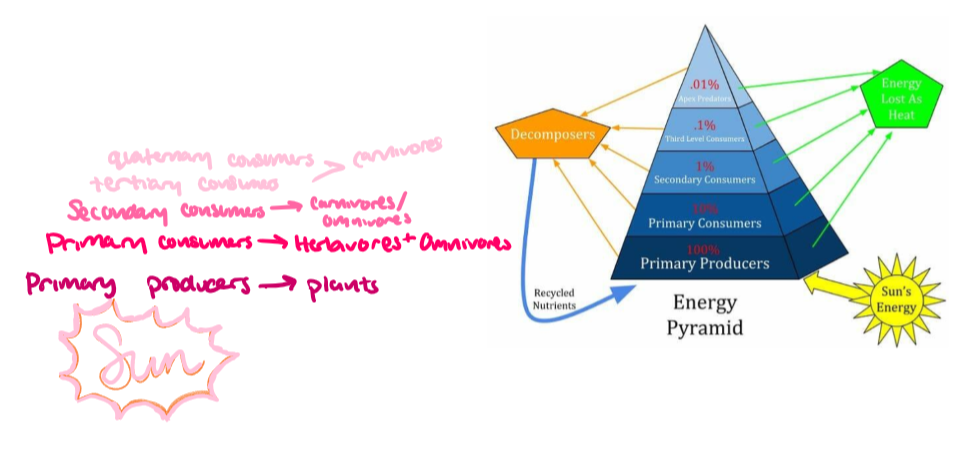
how are biotic and abiotic factors linked
just look at pic
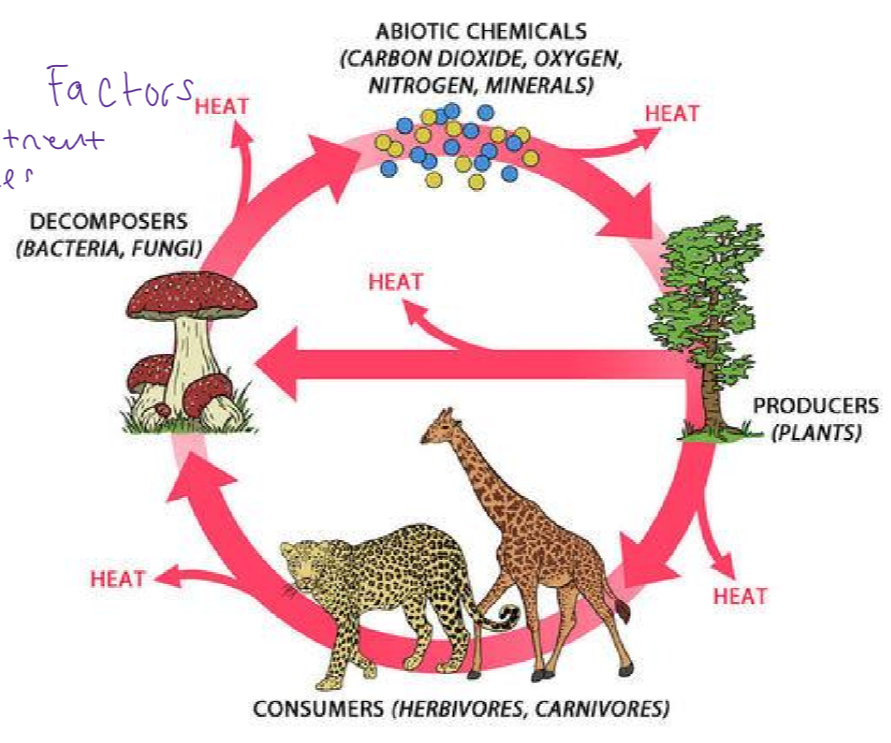
how does water impact the ecosystem
homeostasis (temp and pH regulation), solubility, structure of body
how does carbon impact ecosystem
basic building block of all organisms
how does nitrogen impact the ecosystem
forms amino acids, proteins, and DNA/RNA
how does phosphorus impact the ecosystem
essential to the formation of cell membranes and ATP
water cycle
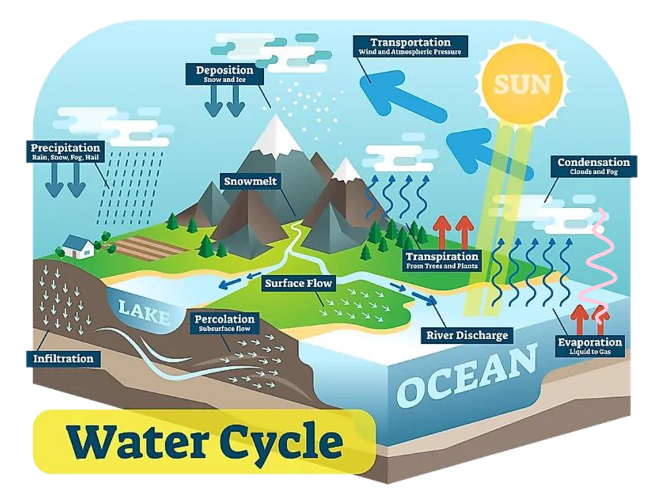
nitrogen cycle
nitrogen is unreactive, so it must be fixed by microorganisms into NH3 (ammonia) and NH4 (ammonium)
nitrifying bacteria turn ammonia and ammonium into nitrates (NO3) and nitrites (NO2), which plants can then use
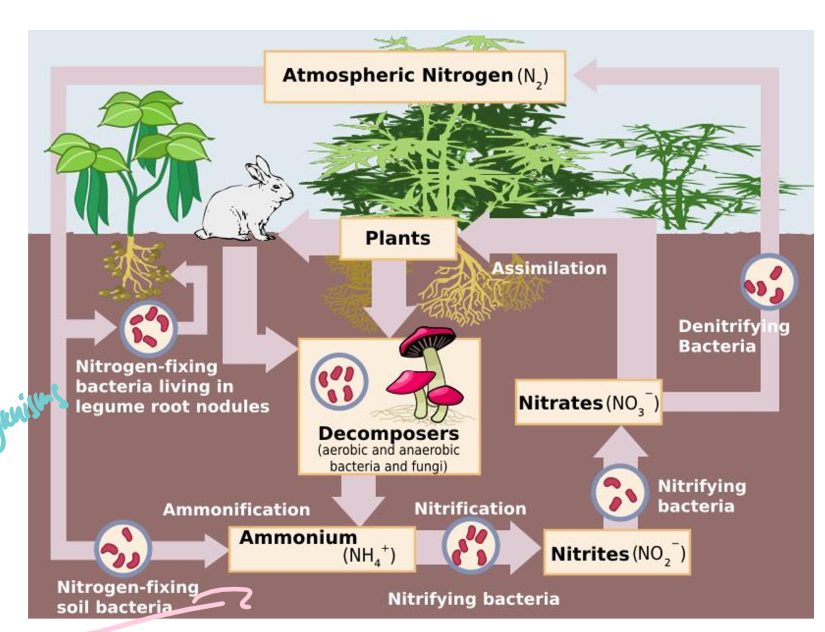
carbon cycle
sediment:
carbon can be stored in rocks, soil, and the compressed in the form of fossil fuels
water can wash the carbon out of soil and weather it out of rocks, pulling the carbon into the ocean where it forms CO3 (carbonate) and CaCO3 (calcium carbonate)
calcium carbonate is used in the shells of sea creatures, and it forms limestone
organisms:
photosynthesis converts CO2 into glucose, removing carbon from the atmosphere
plants die or are eaten and the carbon is exhaled by consumers through cellular respiration
organisms die and reform
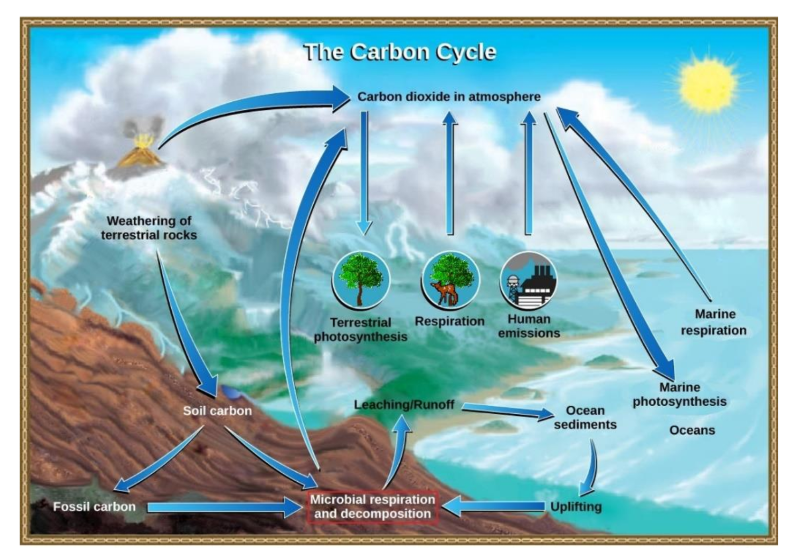
phosphorus cycle
exists as PO4 (phosphate)
weathering of rocks and erosion of soil leeches PO4 from the ground into the ocean
microorganisms absorb PO4 from the soil and create nucleic acids
plants and animals that use phosphorus die and return it to the soil
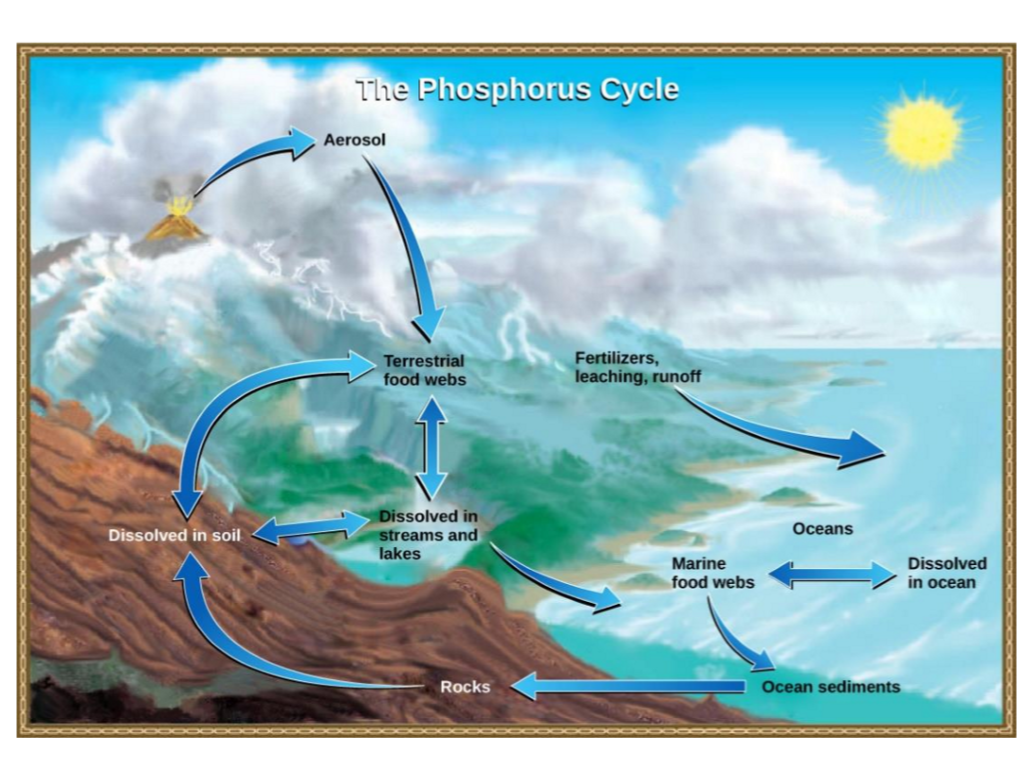
resources
most resources are limited
most things need food, water, and shelter
but also territory
competition
interactions between organisms where both require a resource that is in limited supply
indirect competition (explotiation and apparent)
exploitation competition
competition between organism for a common limited resources
the use of the resource by one organism limits its availability to other organism
exploitation competition happens over TIME
ex: birds and bats eating bugs at different times of day
apparent competition
prey species compete with each other’s fitness level against a shared predator
direct competition (interference competition)
interference competition: competition where organisms enter into direct physical conflict with each other for resources
k-selected
examples: humans, whales, elephants, horse, giraffe
produce fewer offspring and provide long-term care for said offspring (stable environments, long gustative periods)
r selected
produced large numbers of offspring and provide little to no care after birth, unstable enviro., short gestation periods
like turtles, frogs, bunnies
type 1 type 2 type 3
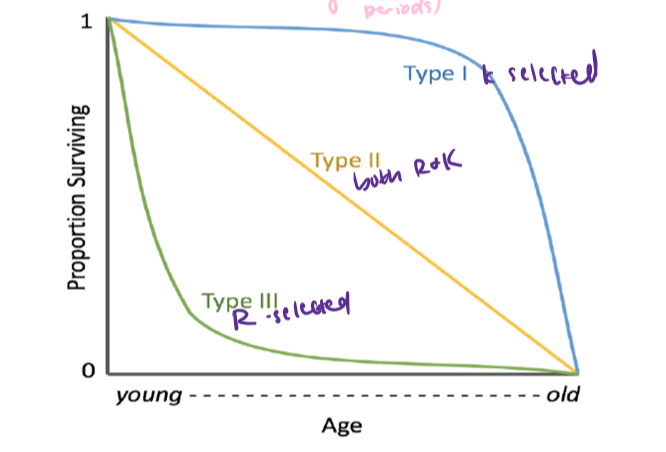
animals are considered extinct when
no indivduals alive or
none in the wild and not enough in captivity to repopulate and maintain diversity (below the critical number)
what causes species to go extinct (HIPPO)
H — habitat loss
I — invasive species
P — pollution
P — population (overpopulation and human population)
O —- overexploitation
what do endangered and extinct species have in common
specialist, k-selected, slow reproduction/growth
low adaptability/low range of tolerance
generalists
highly adaptable organism that have a wide range of tolerance for resources, food, habitat, climate
specialist
low adaptability organisms that have a narrow range of tolerance for resources, food, habitat, and climate
factor most responsible for endangered species
habitat loss
what happens when a nonnative species movesi nto a new ecosystem
competition, there can only be one specie in any niche
poor competitors can:
shift strategy (find new niche/resource)
move
die
what can invasive species do
destroy crops, native plants, small animals, transmit disease, compete with native plants
what determines a biome
temperatures and water/moisture levels
A population of frogs and newts live in the same lake. A small population of catfish prey on both newts and frogs. Scientists notice that as the population of newts increases, the population of frogs decreases even though the resources that both frogs and newts need are abundant. What explains the change in frog population?
This is an example of apparent competition!!! The increase in the newt population allows the catfish to eat more newts, this increase in resources for the catfish allows them to reproduce more and the population of catfish increases. This means there are more catfish to prey on frogs, decreasing the frog population.
water cycle
Sun hits bodies of water so they evaporate
Evaporated water (water vapor) condenses into clouds in the sky
The clouds will release water through rain (precipitation)
Can go to soil, rivers, plants, and repeats
carbon cycle
Carbon is mostly found in the air (CO2), plants, soil, fossil fuels, and animals
Photosynthesis--plants take in CO2 and convert it to glucose and other products
Carbon locked up inside plants can go back to atmosphere through respiration
OR it can be passed on to animals that eat the plants (who can also release carbon dioxide through breathing
When plants and animals die…
Organisms decay and are broken down into smaller pieces until carbon is released through microbial respiration
If the organisms decay in conditions without oxygen, they become fossil fuels, which are burned to produce CO2
nitrogen cycle
We need nitrogen to live but we must absorb it through food
Atmospheric nitrogen comes down to the earth through precipitation
Absorbs into soil and is "fixed" to become ammonia and ammonium
Then, bacteria combine ammonia with oxygen in a process called nitrification (nitrites and nitrates)
Plants absorb these new nitrogen products, and so does denitrifying bacteria that releases nitrogen back to the atmosphere
Animals who eat plants will die/poop and decomposers break down the nitrogen and bring it back to ammonia/ammonium (ammonification) and cycle restarts
phosphorus cycle
Weathering--phosphorus is found in rocks, over time it's released and goes into soil and the water
Absorption--plants/fungi absorb it and grow, and animals will eat them eventually, and phosphorus in the water is digested by animals
Decomposition--animals excrete waste and decomposers use phosphorus in waste, bacteria convert organic phosphorus into inorganic phosphorus
Sediment to rocks--phosphorus gets buried in sediment which eventually becomes rocks; in the ocean, plants and animals absorb phosphorus, die, decompose, and end up as sediment which becomes rock